Hydro-Quebec (HQ) is a major Canadian utility that manages the generation, transmission, and distribution of electricity to more than 3.8 million customers. Its distribution network includes over 12,000 km (7,456 miles) of medium-voltage underground distribution cables and more than 600,000 accessories — each with potential for failure.
Medium-voltage (MV) underground cable systems are a critical part of the distribution network of many electric utilities. Like any other power apparatus, insulation in underground MV cable systems ages over time. In North America, a large number of underground cross-linked polyethylene (XLPE) cables were installed in the 1970s and 1980s with a reported design life in the range of 30 to 40 years.[1] Today, utilities are faced with underground distribution systems that are theoretically either at the end of or past their design life.
RELIABILITY CHALLENGES
The reliability of the electric grid has always been a topic of interest. In-service failures lead to loss of revenue, increase in expenditures for repairs, and potential damage to other power apparatus due to increased stress during the fault. Furthermore, public and personal safety can be compromised, especially when these failures occur in underground vaults and manholes in densely populated urban areas.
Replacing every piece of equipment and accessory that has reached its theoretical design service life is not an option for economical and practical reasons:
- Newly introduced technologies can lead to higher risk of infant failures.
- Each specimen ages at a different rate depending on the operating and environmental conditions.
Therefore, maintenance and diagnostic tests are common practice to assess the health of power system critical assets. This can rapidly become challenging for utilities where available manpower and/or funding might not be available to periodically test every electrical component.
The costs and constraints associated with replacing a network accessory are significant. The planning, work preparation, maneuvers to isolate the problematic equipment, execution of the work, and restoration can easily generate costs of tens of thousands of dollars — and this for an accessory worth only a few hundred dollars.
This situation becomes all the more significant when the problem is associated with a complete set of accessories, or worse, when the quality, precision, or methodology of the tests carried out by the manufacturer is not adequate. A utility can quickly face a major problem when several hundred or thousands of faulty accessories are installed in the network before noticing the problem and determining its source and nature.
In 2005, Hydro-Quebec reported that most of the in-service failures in its underground distribution network occurred at cable joints. A common cause of deterioration in those cable accessories was partial discharges.[2]
This article shows how HQ has implemented a thorough inspection procedure to decrease the rate of failure in their underground distribution network. Among other tools, a multi-level PD detection approach was adopted to minimize the expertise required onsite. Several case studies are used to show the advantage of such an inspection procedure for an underground system.
PARTIAL DISCHARGE THEORY
The theory of partial discharges is very complex, and a complete description is beyond the scope of this article. However, a basic understanding of the phenomenon is helpful from this point onward.
A partial discharge (PD) is a localized dielectric breakdown of a small portion of an insulation system under electrical stress. PD can occur when the local electric field exceeds the local dielectric strength at a given location within or on the surface of an energized object. Each PD event will generate a current pulse. At its origin, if the discharge occurs in atmospheric air, this pulse has a rise time of just a few nanoseconds. It contains a theoretical constant broad frequency spectrum from DC to up to several hundred megahertz (MHz). Therefore, PD can be detected using various technologies.
IEC 60270[3] is a normative document that defines the broad lines of PD measurements in many electrical devices. It specifies the test circuit, type of sensors, and measured frequency range and designates apparent charge (in picocoulombs) as the unit to quantify PD activity. Figure 1 shows an example of a typical PD measurement circuit according to IEC 60270.

Figure 1: PD Measurement Circuit According to IEC 60270
IEC 60270 is primarily applicable for PD measurement performed in controlled environments, such as a factory or laboratory, where interferences can be easily mitigated. PD measurements that comply with IEC 60270 are commonly referred to as conventional PD measurements.
When measuring PD in the field, it can be challenging to comply with every IEC 60270 requirement. Space restrictions, a high level of interference, and the difficulty of performing a valid calibration are among the most common reasons other techniques are used. These are often defined as unconventional PD measurements and are described in IEC 62478.[4]
One example of such a measurement is the use of an antenna as a sensor. The antenna is installed on the surface or near the equipment and captures part of the energy from the electromagnetic wave generated by the discharge activity. In this case, many factors influence the measured quantity; therefore, the assessment usually focuses on whether PD activity is detected rather than quantification of the discharges. A simplified schematic of unconventional PD measurement performed using an antenna is shown in Figure 2.
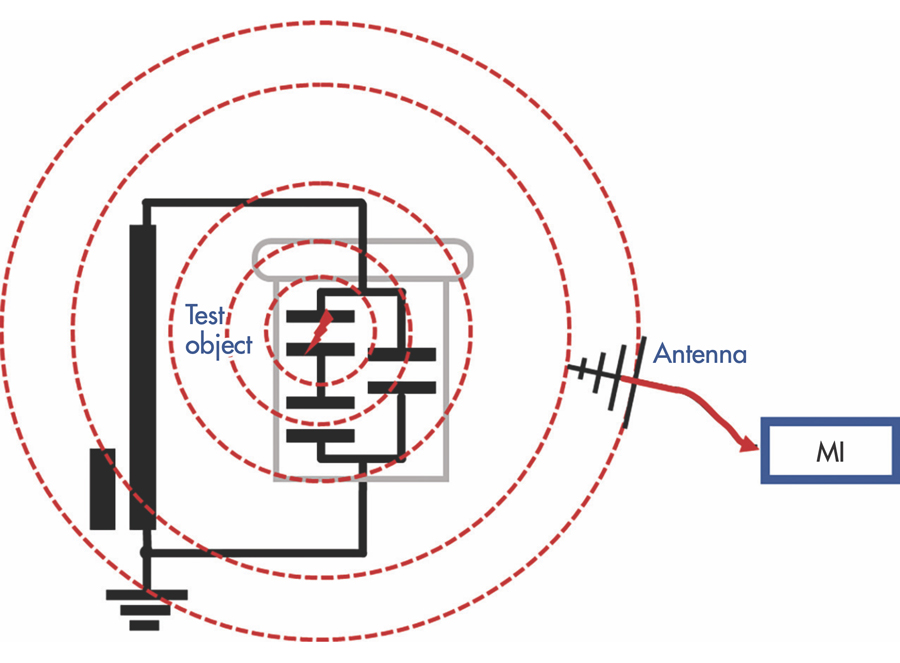
Figure 2: UHF PD Detection Using an Antenna-Type Sensor
INSPECTION AT HYDRO-QUEBEC UNDERGROUND SYSTEM
Over the years, HQ has become a leader in online problem detection. Predictive maintenance to ensure safe access to underground facilities was introduced in 1996 in an exploratory manner. Now, 25 years later, HQ has a mature and sophisticated preventive inspection program that makes it possible to target any potential anomaly of an accessory before an in-service failure occurs. It also provides workers with safe access to underground facilities.
Every vault or manhole should be inspected once every six years, and 30 HQ teams are dedicated to this inspection program, which represents an annual inspection of more than 100,000 accessories in 12,000 vaults or manholes. Every manhole inspected with no anomaly is given an access validity period of one year. In addition to these inspections, several hundred repairs per year must be made in manholes that do not earn this validity period and therefore require emergency inspection.
A manhole inspection has four phases (Figure 3):
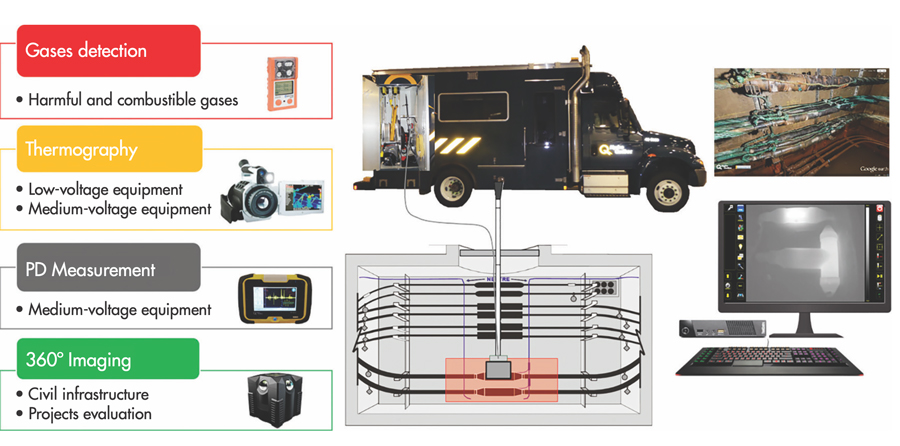
Figure 3: Inspection Program Phases
- Measure potentially harmful and combustible gases.
- Use thermographic measurement of low- and medium-voltage components to identify hot spots.
- Measure PD on medium-voltage accessories.
- Integrate a 360-degree photo into an interactive 3D experience tool to help to plan, visualize, and evaluate events such as a virtual tour of underground installations, optimization of work preparation, evaluation of the degradation of the vault, and new line routing with fewer field visits.
Depending on the test to be performed (infrared or 360-degree imaging), the device is fixed at the end of a pole, which is lowered inside the structure. The cameras are connected by cable to a computer in the thermograph truck. An operator handles the cameras, views the infrared images, and detects hot spots.
Hydro-Quebec has developed diagnostic software to evaluate the performance of splice connection, i.e., the internal temperature of each accessory and the current at which the maximum temperature will be reached given the type of splice, cable size, and ambient temperature (Figure 4).
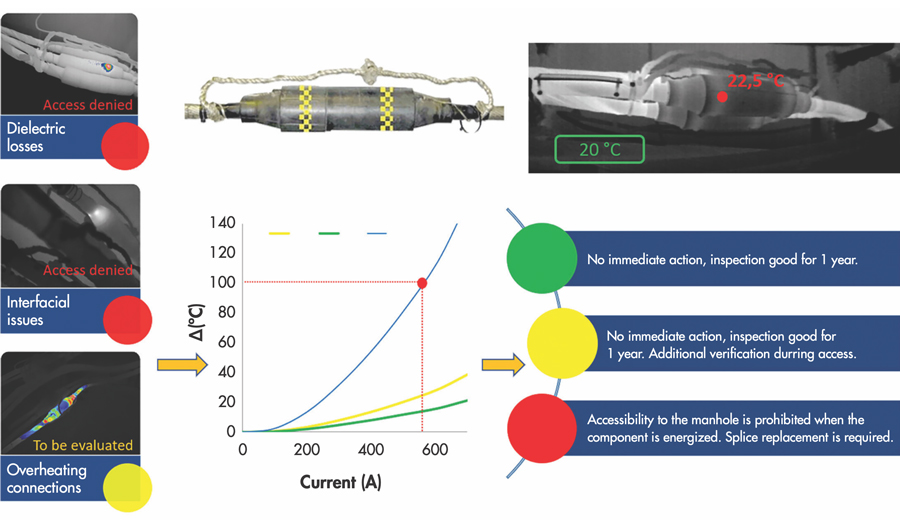
Figure 4: Automatic Evaluation of a Splice Performance
PD measurements are complementary to the thermographic inspection. If no anomaly is detected by thermography, PD measurement is completed on all medium-voltage components present inside the underground vault. Online PD measurements made during HQ’s maintenance program are non-conventional PD measurements, which means that only the presence of PD in an accessory is measured, not its charge in picoCoulombs.[4]
A PD sniffer[5][6][7] has been specifically designed for use by non-expert workers as a first-level safety tool. It can recognize a PD signal in a fully automatic manner without any interpretation. Currently, the PD sniffer is being gradually replaced by a PD alarm,[8][9] a new, lighter, less expensive tool (Figure 5).

Figure 5: PD Alarm Mobile Unit
The PD alarm is able to detect the inversion of polarity of a PD (Figure 6) produced between the two antennas at an operating range below 30 MHz and centered around 18 MHz.[10] This low band frequency allows the use of standard and cheaper electronics for all necessary treatments. The development of antennas is also one of the keys to success.

Figure 6: PD Detection Performed with the PD Alarm Tool
When potential partial discharge is detected by a thermographer, he leaves the manhole and calls the technical team of engineers for validation. An engineer then uses the advanced partial discharge analyzer (PDA)[2][11] to confirm or deny the presence of PD.
CASE STUDIES
Over the years, PD measurements have enabled Hydro-Quebec to detect dielectric anomalies on underground accessories that were aging as well as on accessories newly installed in the network. This helped avoid worker exposure to imminent risk as well as breakdowns and associated costs by removing these problematic accessories before an in-service failure occurred.
Most cases are caused by improper assembly; a minority are caused by manufacturing issues. However, manufacturing issues can have greater negative impact on the network. Although factory tests are carried out by manufacturers of electrical distribution products, a dielectric fault is sometimes detected on the accessory installed in the network. These cases are the most interesting because they are the subject of a more in-depth analysis. Here are several examples of problematic accessories that had passed manufacturers’ tests and had been installed in a network.
Case Study I: 600 A Molded Busbars
600 A molded busbars were installed by HQ linemen in vaults to interconnect molded fuses and transformers (Figure 7). They are also part of a multi-channel solid dielectric switchgear deployed on Hydro-Quebec’s network.

Figure 7: Molded Busbar in Vault
Using the PD sniffer tool, HQ thermographers noticed probable PD on molded busbars recently installed in vaults, and an expert engineer confirmed the presence of PD with the PDA system. He also used the new PD alarm tool, which indicated the presence of PD. After removal, phase-resolved partial discharge (PRPD) analysis done on the defective units (Figure 8) clearly shows the presence of PD.

Figure 8: PRPD Analysis on Molded Busbar
At almost the same time, the test engineer in charge of testing all new equipment prior to being installed in the field measured and confirmed PD on a multi-channel dielectric switchgear. During some open-close operations on the switchgear, the test engineer was able to determine that the PD was coming from the bus work of the apparatus, but he could not determine which component of the bus work was defective. To finalize his analysis, the test engineer used the new PD alarm tool to locate the defective part of the bus work: a 600 A molded busbar.
Following this event, Hydro-Quebec measured PD on new accessories from this manufacturer and confirmed the presence of PD activity on a high percentage of the analyzed accessories.
Based on the PRPD analysis of the tested molded busbars, the test engineer suspected that the PD was created by porosity in the insulation material. X-ray images were taken on three defective molded busbars, and the verdict was the same: There were porosities in the insulation at one end of the molded busbar (Figure 9). The manufacturer analyzed and dissected the returned units and came to the same conclusion. Corrective actions in the molding and PD testing process were then taken by the manufacturer.

Figure 9: X-ray images showed porosities in the insulation material at one end of the molded busbar.
Additional Case Studies
The sequence of events in the following cases is the same as in the previous section:
- Workers detected the presence of PD on an accessory installed in the field using the PD sniffer or PD alarm.
- The presence of PD was confirmed by the technical support team using the PDA.
- The defective accessory was removed from the underground system and replaced.
- When several identical cases were detected, PRPD analysis was done in a laboratory.
- Sometimes an X-ray scan of the accessory was done.
- A report on the origin of PD was written.
- If it was a manufacturing problem, the conclusions were sent to the manufacturer so corrective actions could be taken.
CASE 1
Capacitive Plug of a Separable Cable Joint
In 2011, we observed the presence of PD activity on more than 15 newly installed accessories. Hydro-Quebec has more than 55,000 units of this type of accessory distributed in more than 3,500 underground structures.
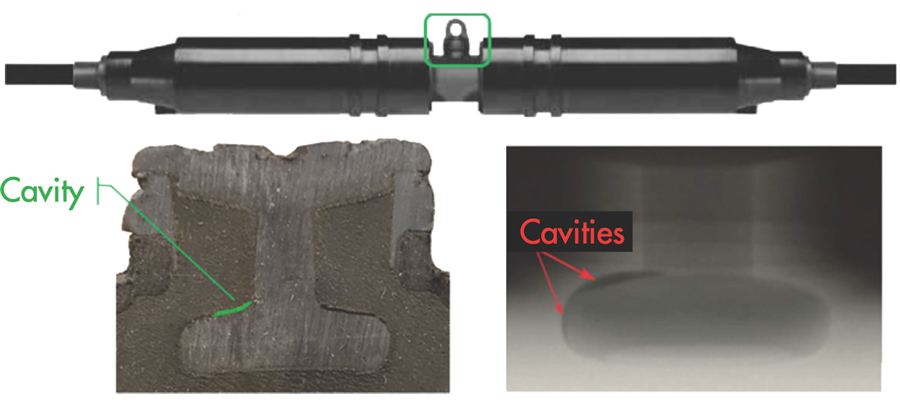
Figure 10: Cavity in a Separable Cable Joint
|
Problems |
A faulty area of the molding was located at the capacitive socket. X-ray images showed that some space was not filled by the insulating material (Figure 10). The manufacturer had changed some molds, and its factory test procedure did not detect the problematic components. |
|
Corrective Actions |
Hydro-Quebec informed the manufacturer of the problem associated with the molding of this type of accessory and returned all its separable cable joints from the same lot to the manufacturer. The manufacturer corrected the molding issue and testing procedures for these components. |
CASE 2
Submersible Epoxy Isolated Fuse
This electrical device is used to provide protection for a submersible transformer in the event of an overload or internal failure. HQ has approximately 2,000 fuses of this type installed in over 500 underground structures.
|
Problems |
PD was caused by air gaps (Figure 11) inside the silicone filling, which is used to fill the void at the interface of three materials: brass, fiberglass, and epoxy. |
|
Corrective Actions |
Hydro-Quebec replaced the fuses with the highest levels of PD. Several tests were performed to determine whether it was safe for workers to be near these components. It was concluded that, due to its location, PD activity does not deteriorate the epoxy insulation. |

Figure 11: Air Gaps in Submersible Epoxy Isolated Fuse
CASE 3
Cap for Grounding Device
This component is installed on pad-mounted switches and is used to isolate the grounding device.
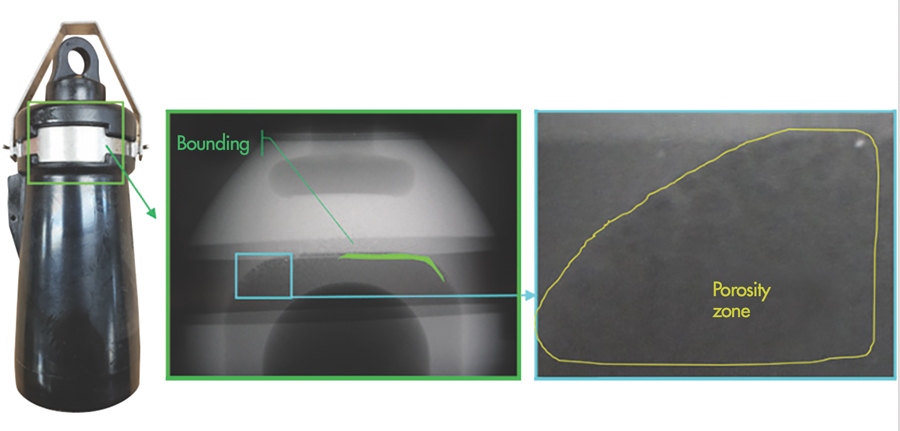
Figure 12: Cap for Grounding Device, Porosity, and Bounding
|
Problems |
PD was caused by porosity in the insulation material and poor bonding between the semiconductor and the insulation material (Figure 12). |
|
Corrective Actions |
During PD factory tests, the grounding cap was temporally installed and maintained using a hydraulic press. The test-bench assembly applied non-uniform pressure to the components and did not reflect the in-service condition. When the manufacturer was informed, the test bench was adjusted to properly detect anomalies. |
CASE 4
T-Elbow on Medium-Voltage Switches
This connection accessory called deadbreak elbow is mainly used to connect an underground cable to a switchgear.
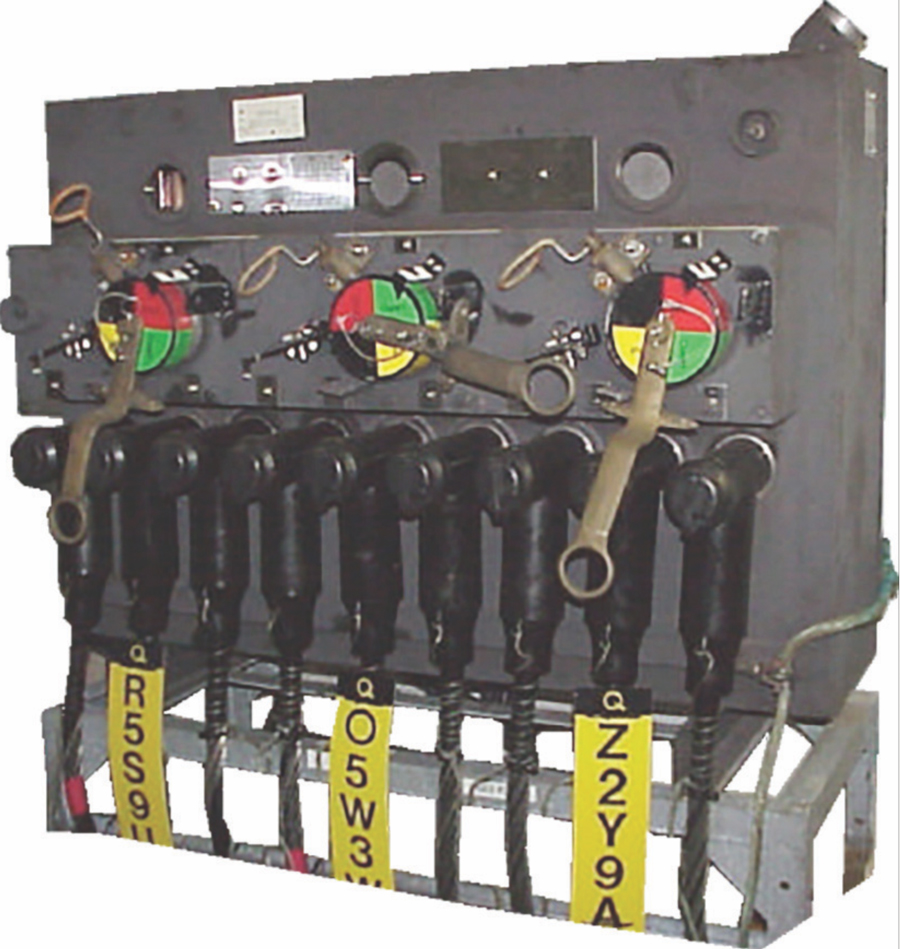
|
Problems |
Several components of this type installed on the network showed PD activity. The problematic components were removed and investigated. It was found that the PD was caused by bad contact between the semiconductor and the lug (Figure 13). |
|
|
Corrective Actions |
Manufacturing tests were made with a connector bigger than the actual connector used in service. The connector used in-service did not make proper contact and generated PD activity. The manufacturer adjusted his test bench and was able to detect accessories that were out of tolerance. |
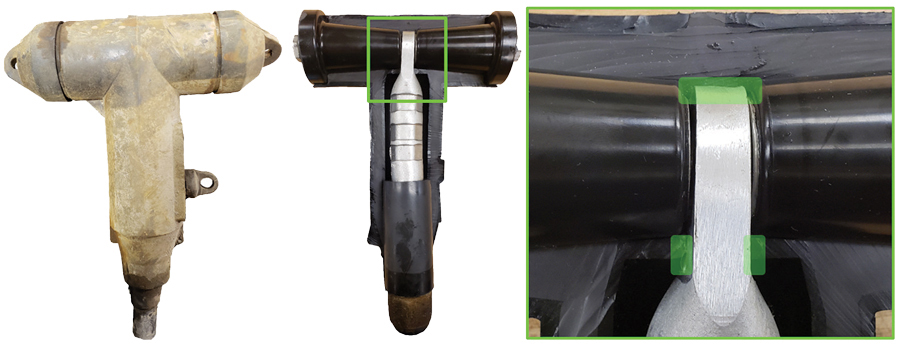
Figure 13: Surface Contact Problem with a T-Elbow
CONCLUSION
Hydro-Quebec’s maintenance program achieves several targets. The first of these targets is the health and safety of employees and the public. By removing potentially dangerous accessories from the network prior to their failure, HQ raises its safety criteria to a high level. It is a priority for the company.
The second target is economic. The maintenance program reduces in-service failures. Performing a repair after an in-service failure is at least two and a half times more expensive than replacing an accessory after an inspection. In addition, when corrective actions are planned, there is little or no service interruption.
The third target is to ensure quality service and continue monitoring best practices. This quality assurance has repercussions on manufacturers since they are notified on certain issues, allowing them to improve their processes.
Approximately 500 anomalies are detected each year by thermography and 100 anomalies by detection of PD. Since the beginning of the maintenance program, the number of anomalies has greatly decreased (Figure 14).
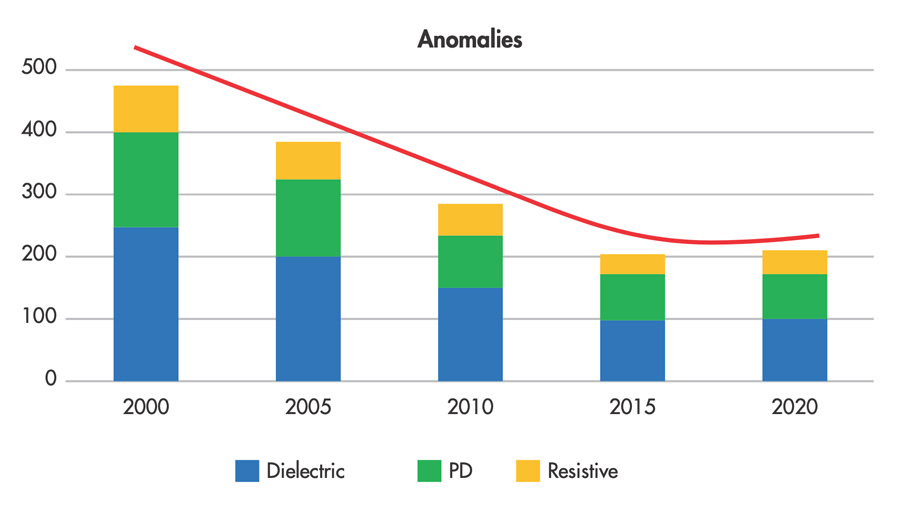
Figure 14: Number of Anomalies vs. Years
References
[1] “Diagnostic Testing of Underground Cable Systems,” Cable Diagnostic Focused Initiative, DOE Award No. DE-FC02-04CH11237, Dec. 2010.
[2] D. Fournier et al. “Detection, Localization and Interpretation of Partial Discharge in the Underground Distribution Network at Hydro-Quebec,” CIRED 2005 — 18th International Conference and Exhibition on Electricity Distribution, Turin, Italy, 2005, pp. 1-4, doi: 10.1049/cp:20050961.
[3] International Electrotechnical Commission. IEC 60270, High-Voltage Test Techniques —Partial Discharge Measurements, Edition 3.1.
[4] International Electrotechnical Commission. IEC TS 62478-2016, High-Voltage Test Techniques — Measurement of Partial Discharges by Electromagnetic and Acoustic Methods, Edition 1.0.
[5] F. Léonard et al. “Partial Discharge (PD) Sniffer for Worker Safety in Underground Vaults,” Acts of the CIRED Conference, 2011.
[6] L. Reynaud, D. Pineau, M. Charette. “Partial Discharge (PD) Automatic Diagnosis Tool for Worker Safety in Underground Vaults, Jicable’11 Conference, Versailles, France, 2011.
[7] F. Léonard. “Dynamic Clustering of Transient Signals,” United States Patent Application Publication, US 2014/0100821 A1.
[8] L. Reynaud, D. Pineau, M. Charette, M. Trépanier. “PD Alarm — Lightweight Automated Diagnostic Device for Online Detection and Location of Partial Discharges on Non-Shielded Accessories of a Medium-Voltage Distribution Network,” Jicable’19 Conference, Versailles, France, 2019.
[9] L. Reynaud, M. Trépanier, D. Pineau, M. Charette. “PD Alarm Tool for Online Detection of Partial Discharges in Medium-Voltage Accessories: Technology and Case Studies,” Acts of the DOBLE Conference, Boston, MA, USA, 2020.
[10] D. Pineau, L. Reynaud, M. Charrette. “Détecteur de Décharge Partielle et Méthode Associée,”United States Patent 0297-PCT-US ; Canada Patent Pending 0297-PCT-CA, 2019.
[11] D. Fournier et al. “Detection, Localization and Interpretation of Partial Discharge,” United States Patent US 8,126,664 B2, 2012.
 Michel Trépanier worked in the Underground Distribution Division of Hydro-Quebec (HQ) in Montréal, Canada, from 2006–2009 as a Technical Support Engineer for the inspection teams in predictive maintenance, location, and analysis of underground faults. In 2010, he joined the Underground Distribution Standards Department, where he specializes in thermal inspection, partial discharge analysis, and characterization of medium-voltage electrical accessories. He contributed to several expertise and innovation projects at the Hydro-Quebec Research Institute. Michel obtained his engineering degree in electrical energy and electrical networks at École de Technologie Supérieure de Montréal in 2005.
Michel Trépanier worked in the Underground Distribution Division of Hydro-Quebec (HQ) in Montréal, Canada, from 2006–2009 as a Technical Support Engineer for the inspection teams in predictive maintenance, location, and analysis of underground faults. In 2010, he joined the Underground Distribution Standards Department, where he specializes in thermal inspection, partial discharge analysis, and characterization of medium-voltage electrical accessories. He contributed to several expertise and innovation projects at the Hydro-Quebec Research Institute. Michel obtained his engineering degree in electrical energy and electrical networks at École de Technologie Supérieure de Montréal in 2005.
 Claude Tremblay is an Electrical Engineer with more than 25 years of experience in engineering and project management at Hydro-Quebec. Since 2010, he has been actively involved in standards development for Hydro-Quebec and the Canadian Standards Association. Claude presently leads a team that provides technical support to his organization’s project planners and linemen. He specializes in conventional PD testing on medium-voltage equipment and accessories. Claude graduated from Sherbrooke University and is a licensed member of the Ordre des ingénieurs du Quebec.
Claude Tremblay is an Electrical Engineer with more than 25 years of experience in engineering and project management at Hydro-Quebec. Since 2010, he has been actively involved in standards development for Hydro-Quebec and the Canadian Standards Association. Claude presently leads a team that provides technical support to his organization’s project planners and linemen. He specializes in conventional PD testing on medium-voltage equipment and accessories. Claude graduated from Sherbrooke University and is a licensed member of the Ordre des ingénieurs du Quebec.
 Lionel Reynaud has been involved in research and development of numerous control and monitoring systems at the Hydro-Quebec Research Institute (IREQ) in Varennes, Canada, since 1998. Since 2003, Lionel has specialized in problems related to cables and accessories at Hydro-Quebec’s underground medium-voltage distribution network. As Project Manager, he led the deployment of tools for fault location and partial discharge detection. Lionel obtained a University Technological Diploma in electrical engineering and industrial computing and an MS in computer systems at the Higher Institute of Aeronautics and Space in Toulouse, France.
Lionel Reynaud has been involved in research and development of numerous control and monitoring systems at the Hydro-Quebec Research Institute (IREQ) in Varennes, Canada, since 1998. Since 2003, Lionel has specialized in problems related to cables and accessories at Hydro-Quebec’s underground medium-voltage distribution network. As Project Manager, he led the deployment of tools for fault location and partial discharge detection. Lionel obtained a University Technological Diploma in electrical engineering and industrial computing and an MS in computer systems at the Higher Institute of Aeronautics and Space in Toulouse, France.
 Mathieu Lachance joined OMICRON electronics Canada Corp. in 2019 and presently holds the position of Regional Application Specialist for rotating machines and partial discharges. Matthieu previously worked as a test engineer in the fields of partial discharges and high voltage. He received a BS in electrical engineering from Université Laval in 2014.
Mathieu Lachance joined OMICRON electronics Canada Corp. in 2019 and presently holds the position of Regional Application Specialist for rotating machines and partial discharges. Matthieu previously worked as a test engineer in the fields of partial discharges and high voltage. He received a BS in electrical engineering from Université Laval in 2014.
